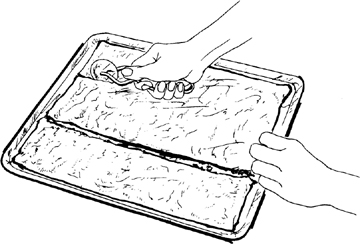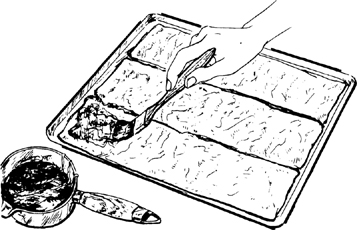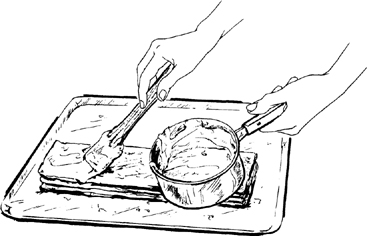Mastering the Art of French Cooking, Volume 2 (198 page)
Read Mastering the Art of French Cooking, Volume 2 Online
Authors: Julia Child

the filling—3 to 4 cups needed:
Either one of the custard fillings in Volume I, pages 590–2, including
crème pâtissière, crème Saint-Honoré,
or the almond custard,
frangipane;
Or crème Chantilly meringuée,
the whipped cream stiffened and sweetened with an
Italian meringue mixture
If needed: 1½ packages (1½ Tb) plain unfavored powdered gelatin softened in ¼ cup liquid (diluted kirsch or plain water)
Prepare one of the fillings suggested, and chill. It must hold its shape enough when spread over the pastry so that you can make layers almost ½ inch thick; if it seems too soft, strengthen it with gelatin just before using the filling as follows: sprinkle gelatin over liquid in a small saucepan; when softened,
heat until completely dissolved. Let cool (or stir over ice) until almost syrupy; then fold into the filling.
icing for mille-feuilles:
About 1 cup confectioner’s sugar in a fine-meshed sieve
This is all you will need for icing
mille-feuilles.
icing for Napoleons:
1 cup white fondant
frosting
, in a small saucepan with 2 Tb kirsch
A larger saucepan of simmering water
A wooden spoon
A rubber spatula or flexible-blade metal spatula
Just before you are to ice the assembled Napoleons, Step 4, stir fondant and kirsch over simmering water until perfectly smooth and just enough liquefied to coat spoon fairly heavily. Use at once.
1 Tb instant coffee
¼ cup water in a small saucepan with cover
8 ounces semisweet baking chocolate
A larger saucepan of simmering water to hold chocolate pan
A wooden spoon
A paper
decorating cone
Dissolve coffee in water over heat; remove from heat, break up the chocolate, and stir it in. Remove pan of simmering water from heat, set chocolate pan in it, stir up, and cover pan. Set aside to melt for several minutes, then stir vigorously until perfectly smooth and creamy. Keep over warm (not hot or simmering) water until ready to use. Prepare paper cone as described and illustrated, and cut opening about ⅛ inch in diameter.
4)
Assembling
NOTE
: If pastry seems flaky or crumbly, cut it with a serrated knife rather than pastry wheel, using the knife like a saw. See also
Manufacturing Notes
, on forming individual portions rather than long strips.
Even sides and ends of pastry by trimming with pastry wheel or serrated knife. With a guide of some sort, such as a pastry sheet or a ruler, mark pastry with the point of a knife, dividing it into 3 even strips; |
|
| Paint top of each of the 6 strips with warm apricot glaze. |
For Napoleons, rapidly spread as even a layer as possible of white fondant over each. |
|





